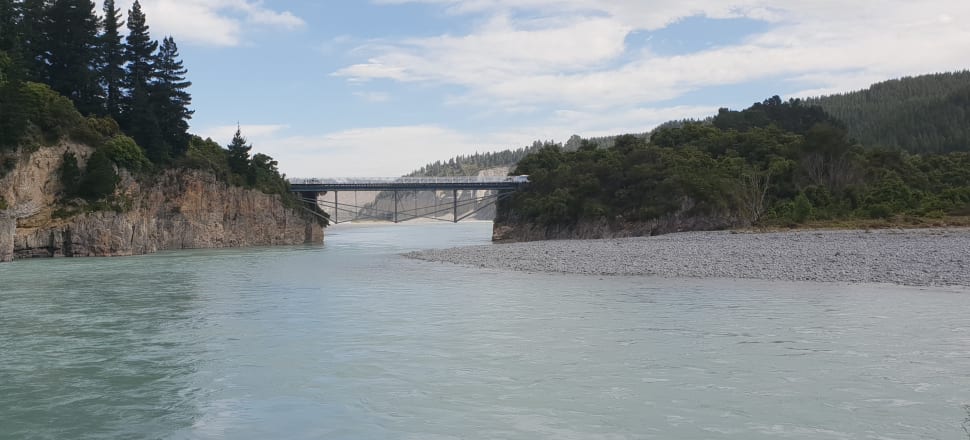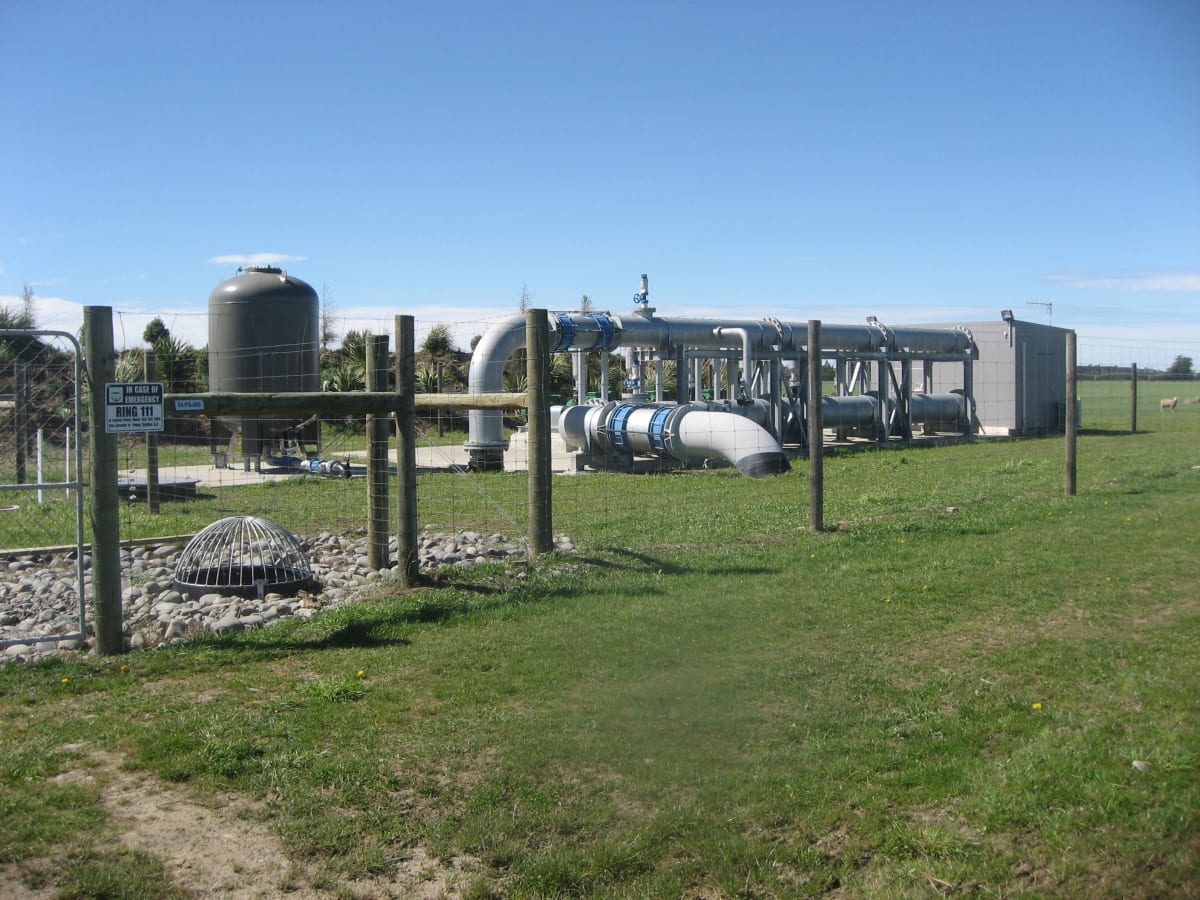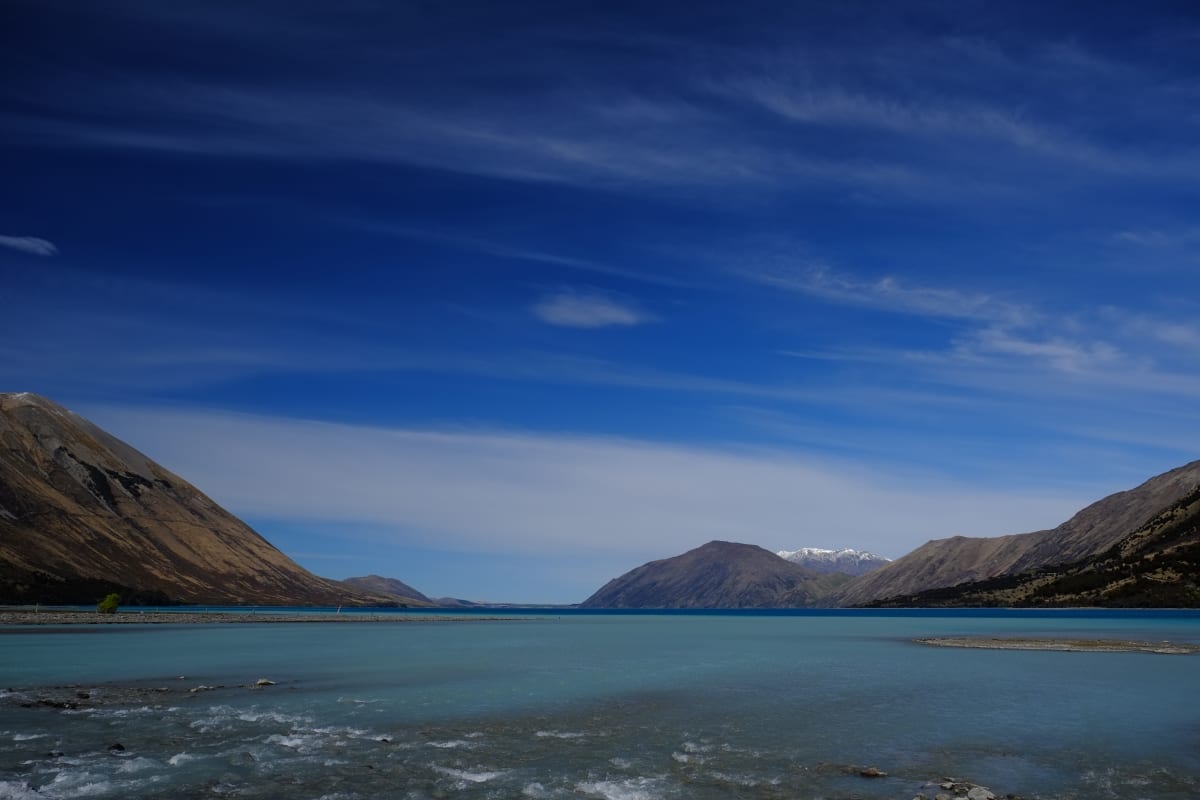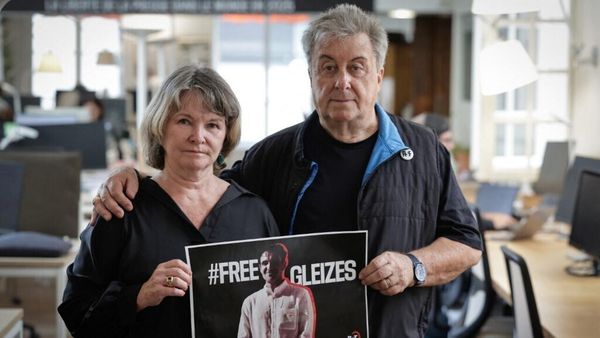
Regional council ECan outlines the difficulty of monitoring Rakaia River consents, and how little it knows. David Williams reports
Fresh analysis of irrigation takes from Canterbury’s Rakaia River appears to back the findings of a leaked scientific report the regional council tried to disown.
Central Plains Water, the South Island’s largest irrigator, has been in the spotlight since a regional council report – leaked to Newsroom last year – suggested it was breaching water-take consents by taking too much water.
The report’s author, senior ECan hydrologist and data analyst Wilco Terink, who spent more than two years compiling it, left last year after his bosses signalled they wanted to remove contentious findings.
In April, an ECan compliance manager, talking about water taken from the Wilberforce River by NZX-listed power company Manawa Energy (formerly Trustpower), said the report was “not an ECan report and we will not be commenting on unsubstantiated information”.
In the background, however, the regional council was working to verify the yet-to-be-released report’s findings.
ECan operations director Katherine Harbrow told Newsroom last week it has, since January, been conducting a “full and detailed assessment of compliance” with all of the company’s consents on the Rakaia, with “further refined analysis” by its surface water science team.
The analysis – “still in draft form” – indicates “the potential for non-compliance”, she says.
If true, this backs Terink’s findings the company “exceeds its consented rates”.
Central Plains, which ECan refers to as CPWL, uses an “averaging” method to determine what water’s available from so-called “subservient consents”. (ECan’s science team agreed to the strategy in 2015, but without putting that agreement in writing.)
ECan’s recent analysis says this method “does not accurately reflect how water is being abstracted under these consents”, Harbrow says, with takes being “at or close to the maximum rate limit periodically at some of intakes”.
“No water is available to CPWL under these consents at these times, so if it were to abstract water at the remaining average rate, [original emphasis] exceedance of the individual consent limit would occur.”j
Harbrow is at pains to point out more water will be available than estimated at other times because the takes are an average.
Some might say that’s not the point – consent conditions should be met, and when they’re not, the regulator should know.
That’s especially true in Canterbury, which, in 2019, had almost two-thirds of the country’s irrigated land, at 467,000 hectares – an area slightly bigger than our second-biggest national park, Kahurangi.
As of June last year, Central Plains provided 191 million cubic metres of water to irrigate 45,000 hectares – an area larger than combining Canterbury’s three biggest lakes: Ellesmere/Te Waihora, Pukaki and Tekapo.
Central Plains Water’s chief executive Mark Pizey says via email: “CPWL are of the view that they are in compliance with all the consents they hold.
“The absence of any notification from ECan to the contrary supports this view.
“CPWL is continuing to work with ECan in finalising the Rakaia River Water Balance Report and look forward to the outcome of this work.”
It’s worth remembering the legitimacy – and the lending – public bodies gave Central Plains from the get-go.
The first consent application, in 2001, was made by the Christchurch City and Selwyn District Councils, with the Ashburton Community Water Trust. The CPW Trust was formed in 2003, with trustees appointed by the councils and Ngāi Tahu. Central Plains Water Ltd implements and operates the scheme.
The irrigation scheme benefited from millions of dollars of loans from public bodies – Crown Irrigation Investments, the Ministry for Primary Industries’ Irrigation Accelerator Fund, and the Selwyn District Council.
Harbrow, of ECan, says it understands Central Plains has launched its own review of the averaging method “using actual abstraction data”. It expects to receive a copy of the analysis and will respond “appropriately”.

In March, the Environmental Defence Society said there was agreement in principle – jointly with ECan and statutory body Fish & Game – to seek an Environment Court declaration over concerns the water conservation order has been breached.
EDS chief executive Gary Taylor says it’s clear from ECan’s response to Newsroom the regulator has an information deficit on the Rakaia, which makes its compliance, monitoring and enforcement work “challenging”. Harbrow’s comments are an honest commentary, he says. “It reflects a council that’s potentially heading in the right direction.”
Meanwhile, Peter Trolove, president of advocacy group Federation of Freshwater Anglers, says ECan is, at the very least, negligent for issuing complex and unworkable water consents.
“It also seems clear that ECan would have been unable to monitor compliance even if they were moved to do so – proof that there has been no compliance monitoring to date which is pretty much what Wilco identified.”
Vanessa Winning, chief executive of industry group IrrigationNZ, says ECan appears to be doing as much as it can to manage and monitor consents, and ensure minimum flows are met.
“The monitoring and management of the waterways is complex and difficult on a daily basis for obvious reasons and being able to work with consent holders means you are more likely to get compliance and improvements than having unworkable applications that people avoid.
“Collaboration and shared goals means outcomes are more likely to be met, surely working with your ratepayers to get those outcomes is [a] better approach?”
Harbrow says ECan is committed to ensuring CPWL is fully compliant with its water-take consent.
“We are confident we now have sufficient data, understanding, and oversight to ensure CPWL will in future not take any water that would result in either non-compliance with its resource consent or exceedance of the … Rakaia WCO [water conservation order].”
Perhaps this statement is designed to reassure the public. However, CPW started delivering water to its customer/shareholders in September 2015, and it’s only now ECan has reached this conclusion.
That’s concerning enough, but as we’ll learn later, ECan is still flying blind on other Rakaia River water consents.
(This situation might have been revealed sooner but ECan chose to respond to Newsroom’s questions under the Local Government Official Information and Meetings Act – pushing out answers for four weeks.)
Complexity raises questions
It’s worth highlighting the complexity of the Rakaia consenting regime, not only to show how difficult it is to monitor but, in some cases, how little ECan knows.
The Rakaia’s water conservation order – enacted in 1988 and amended in 2011 and 2013 – sets different monthly minimum flows designed to protect the river’s “outstanding characteristics and features” between the Rakaia Gorge and the sea.
Above that minimum flow, the WCO stipulates water can be taken by irrigators on a one-to-one basis. For example, in September, when the minimum flow is 90 cubic metres per second, let’s assume the flow is 110 cumecs. In that case, of the 20 cumecs above the minimum, 10 cumecs stay in the river and the other 10 cumecs can be taken.
(The Terink report said there’s evidence the WCO is being breached; that the river is being impeded and manipulated beyond what was anticipated.)
Water consents are broken into 25 so-called “flow bands” that determine the prioritisation – the oldest consents can take water for longer when restrictions kick in, making their water more reliable.
This presented a problem for Central Plains Water, given it was essentially last in the consent queue, having the least reliable water. The way around that was a consent condition allowing it to take water not used by other consent holders – as long as minimum flows were maintained.
An important prerequisite, however, was the requirement for written permission from other consent holders. However, Harbrow confirms ECan doesn’t always demand it.
For example, ECan waived the condition for consents now held by Central Plains, or for companies in which it’s a shareholder.
Water extracted on behalf of giant corporate farmer Dairy Holdings Ltd – Fonterra’s largest milk supplier and shareholder – “we do not consider the written approval to be required ... in the circumstances”.
It’s not clear, either, if there’s written approval for water taken by Central Plains that was allocated to the Barrhill Chertsey irrigation scheme. An arrangement began in 2015 and ECan says it’s now notified annually of the amounts involved.
What if there’s a breach?
As ECan’s Shaw told Newsroom last year: “There is a statute of limitations that only allows us to take action within 12 months of when we should have reasonably become aware an offence took place.”
If data is supplied annually, and analysis takes months, enforcement action might be ruled out.

Harbrow says Central Plains can take unused water from 13 “subservient” consents, using an “averaging” approach. Believe it or not, this is where things get more complicated.
Water consents generally have two important figures – the instantaneous rate of take, measured in litres per second, and an upper volume limit, measured in cubic metres.
In Harbrow’s example, a consent might have a rate of 450 litres per second and a period volume of 207,000 cubic metres over 30 days. Because of the volumetric limit, the average rate is 370L/s.
Under the averaging method, that means 80L/s is “considered to be available to CPWL to take over the entire irrigation year”. Altogether, Central Plains considers 4281L/s is “available” under all subservient consents.
The question for ECan is: does it know if limits stipulated in those subservient consents, and those controlled by Central Plains, are being met?
Central Plains’ consent clearly states its water takes can’t exceed the combined maximum rates of subservient consents, and it must comply with the minimum flow requirements “of each consent”, and the water conservation order, “at all times”.
To get its calculations right, CPW has to account for the seven consents it owns or manages, takes from the 13 subservient consents, at 24 separate intakes, while accounting for water allocated under unrelated consents. Plus whether it has ordered stored water released from Lake Coleridge by Manawa Energy.
In what seems an understatement, Harbrow says compliance is a “complex undertaking”, and goes on to seemingly knock its data analysis capability.
“Inaccurate or incomplete water abstraction data for one or more of the 20 intakes involved means any subsequent compliance analysis can only be considered indicative.”
(The Terink report was clear-cut, saying Central Plains “exceeds its consented rates”.)
Central Plains concocted the averaging method because it couldn’t – “as required under condition 20 of its consent” – establish real-time abstraction data under subservient consents “because of access issues”.
ECan accepted this as a “practical” approach, and said it no longer had to comply with condition 20. Yet, the council now says the averaging method it approved doesn’t accurately reflect how water is being abstracted under these consents.
Yes, Central Plains doesn’t take subservient water all the time, and under an averaging regime it might exceed some instantaneous rates and not others.
When water takes are high, with all farmers wanting to irrigate their paddocks, who’s checking Central Plains’ “averaging” method isn’t tipping the total water takes from the Rakaia over the consented maximums?
Who is calculating, on each given day, how much water is taken by each consent holder, to ensure limits are adhered to and the river’s minimum flows are preserved? In fact, are all takes metered? Is all data collected and analysed?
The suggestion from Terink’s report is it’s the first time ECan has analysed the water-take numbers.
Worrying picture
Harbrow says CPW is compliant over 30 days. However, compliance with the day-to-day rate “is a more complex assessment” – and was one of the catalysts for Terink’s report.
This comment seemingly jars with what ECan’s surface water science manager Helen Shaw told Newsroom last year – “the Rakaia water balance report is not a compliance report”.
Because of its recent analysis, ECan has concluded it needs to be able to assess Central Plains’ compliance “more accurately”, Harbrow says, by comparing “total abstraction to the total allocation”.
Many would say that’s just a regulator doing its job. But as the Terink report said, ECan’s ability to check consent compliance was “very difficult if not impossible”.
Harbrow’s picture of ECan’s broader compliance work is also worrying.
Putting aside Central Plains’ intake, there are 90 other active intakes on the Rakaia River. To June of last year, water abstraction data was only provided for 81 of those intakes. ECan is chasing up the “late” data.
Of those 90 intakes, in the last five years ECan has assessed only 70 of those for compliance with consent limits, restrictions and the water conservation order.
“The remaining 20 intakes have either been monitored over 5 years ago (4 intakes) or have not yet been monitored (16 intakes),”
Let’s pause there.
For years, anglers, jetboaters and kayakers have complained about low flows and water levels in the Rakaia River, and the body charged with enforcing a water conservation order – akin to national park status for rivers – isn’t even monitoring all the consents.
Not only that, but faced with a scientific report which says there’s evidence of breaches, ECan bosses conduct multiple internal reviews, and signal they want the more contentious findings removed.
In answer to an official information request for the report, it releases a sanitised “draft”. Its unvarnished contents only come to light because of a leak.
Now, Harbrow says, a full and detailed assessment is underway of the 82 consents covering the 90 active intakes. “We are aiming to complete this work by the end of 2022.”
Why does the public care about all this?
The rise of intensive farming, especially dairying, on Canterbury’s plains, and the associated water pollution, has been hugely controversial. The tables turned in favour of irrigators after 2010, some say, when the John Key-led Government sacked ECan’s councillors and installed government-appointed commissioners.
The late Murray Rodgers, of lobby group Water Rights Trust, said in a 2016 opinion piece the government was reluctant to legislate for environmental sustainability, and ECan was loathe to prosecute transgressors.
“We consider the time is well overdue for rural industry leaders to take a strategic look at other land use options to reduce the emphasis on intensive dairy (sheep-dairy, organic/biologic farming, for example) and towards directing diversity into environmentally sustainable land-use.”
Someone well-placed to comment on ECan’s water consent woes is Christine Rose. She’s a former deputy mayor of the Rodney District Council and former deputy chair of the Auckland Regional Council, who is now the lead agricultural campaigner for environmental lobby group Greenpeace.
In her political life, Rose was a resource consent commissioner.
She says it’s assumed when consents are granted they’ll be complied with, or compliance will be monitored. It’s unexpected for agencies to exercise their own discretion about monitoring or enforcing compliance – or, as Rose puts it, to “make it up as they go along”.
It’s also highly irregular for a company to have the discretion to develop an alternative strategy for taking water, which Rose describes as “smoke and mirrors”, and possibly illegal.
She compares the averaging method to being caught driving down a motorway at 200kmh, and telling the police officer it’s OK because at other times it was only going 30kmh.
“It doesn’t work like that in society and it doesn’t work like that nature. So it shouldn’t work like that for the regulators, and it shouldn’t work like that for the companies taking the water.”
ECan is taking a “shameful” laissez faire approach, she says, by going along with something which appears to be causing environmental degradation.
“These bottom lines are set because of ecological reasons,” she says.
“It’s not going to be any consolation to the creatures that live in the river, that, oh, it’s alright because it’s just an average. This is about the life support and capacity of the flows.”







